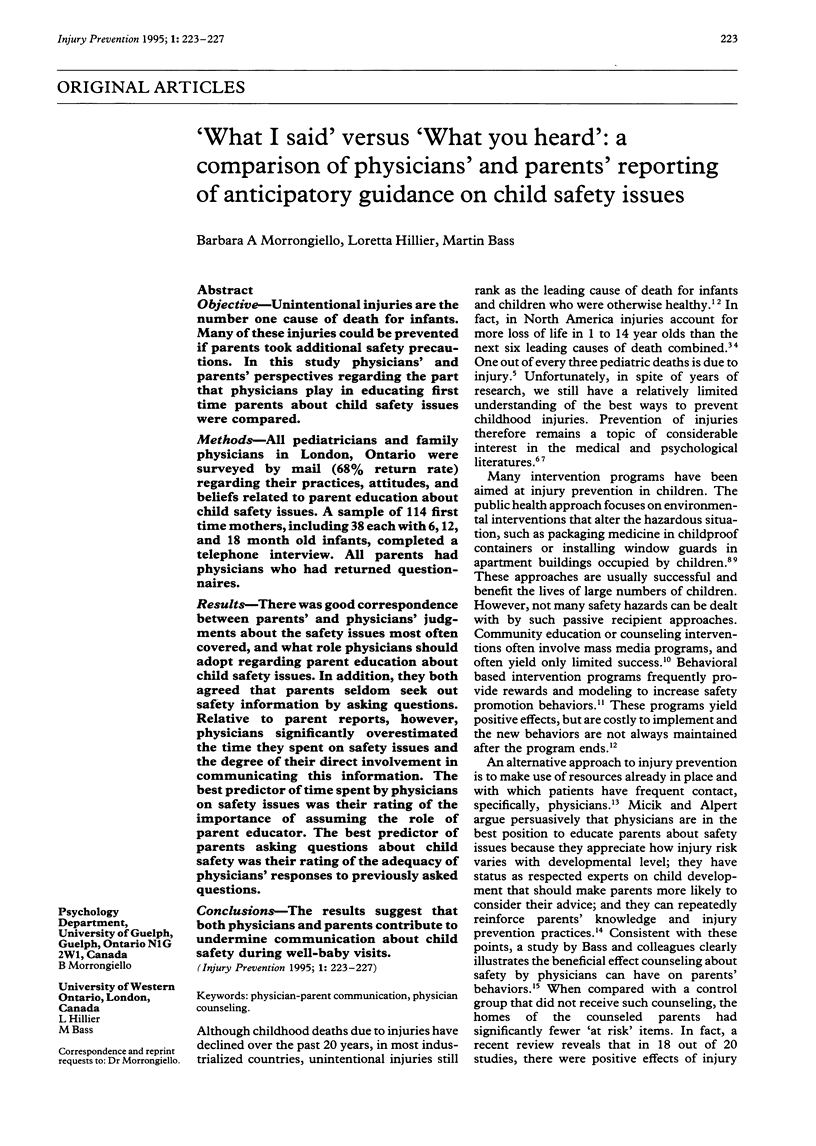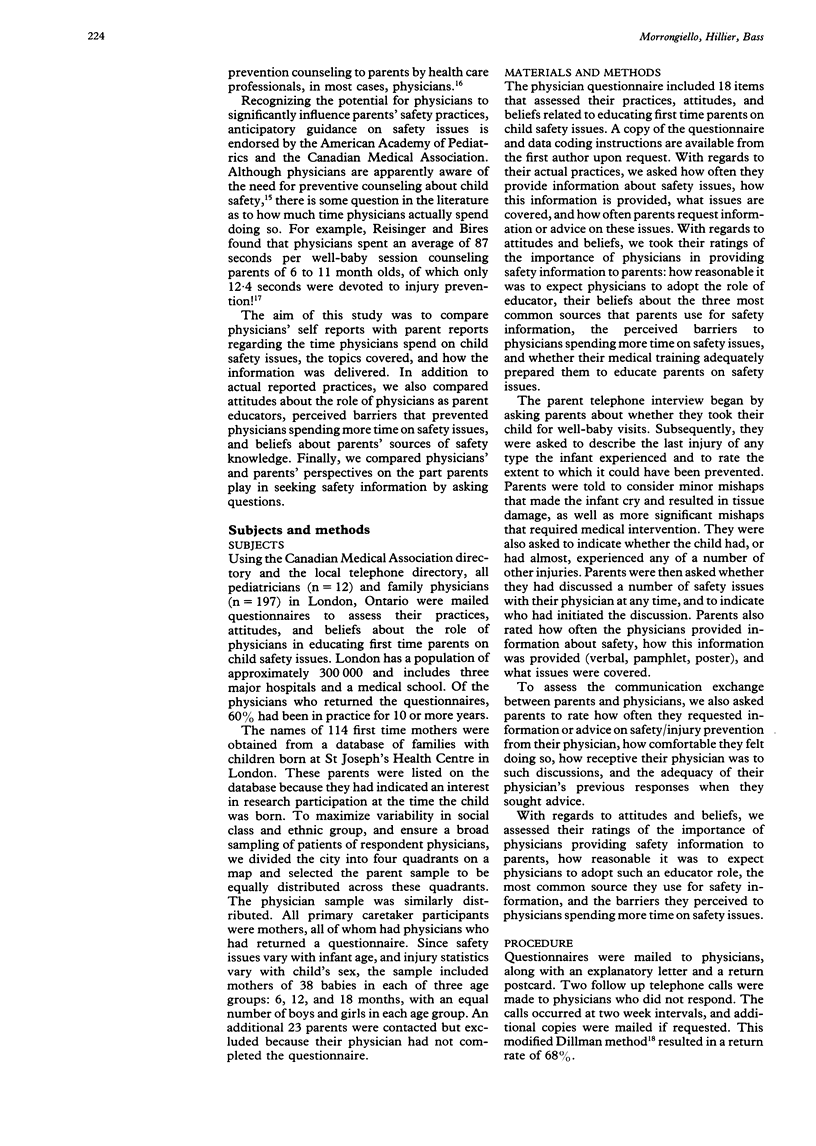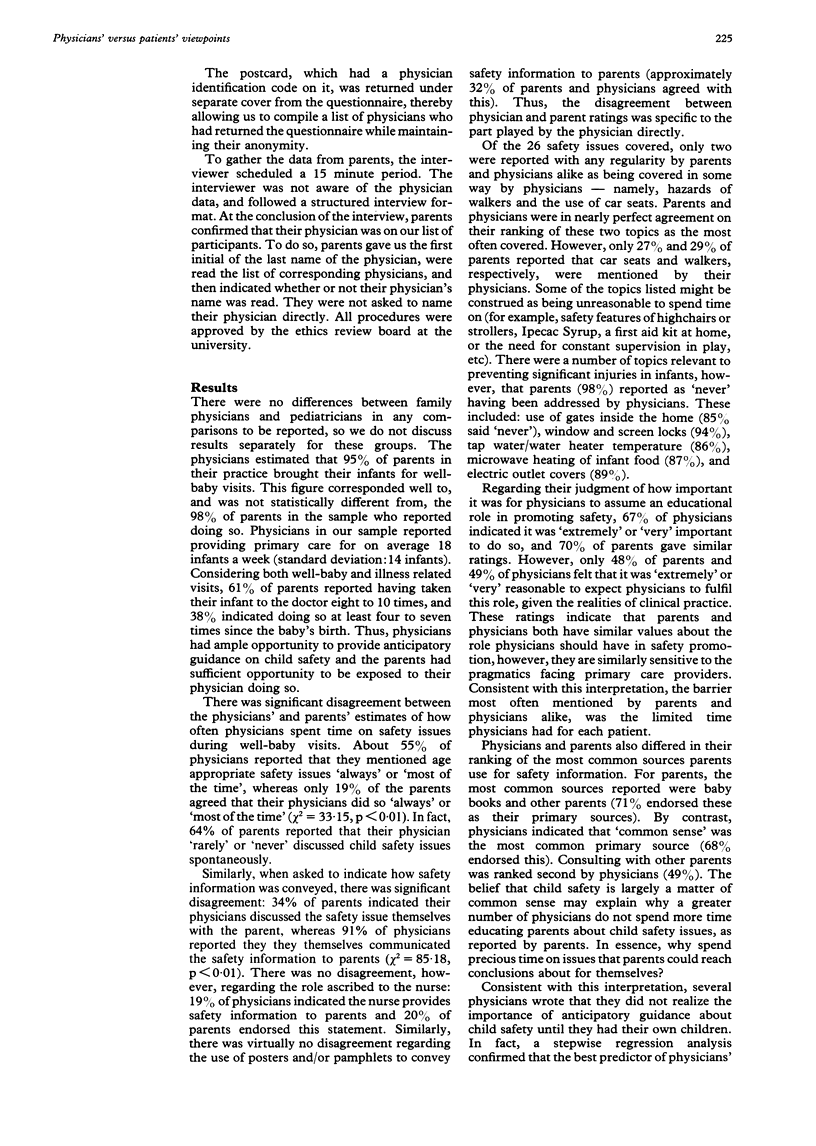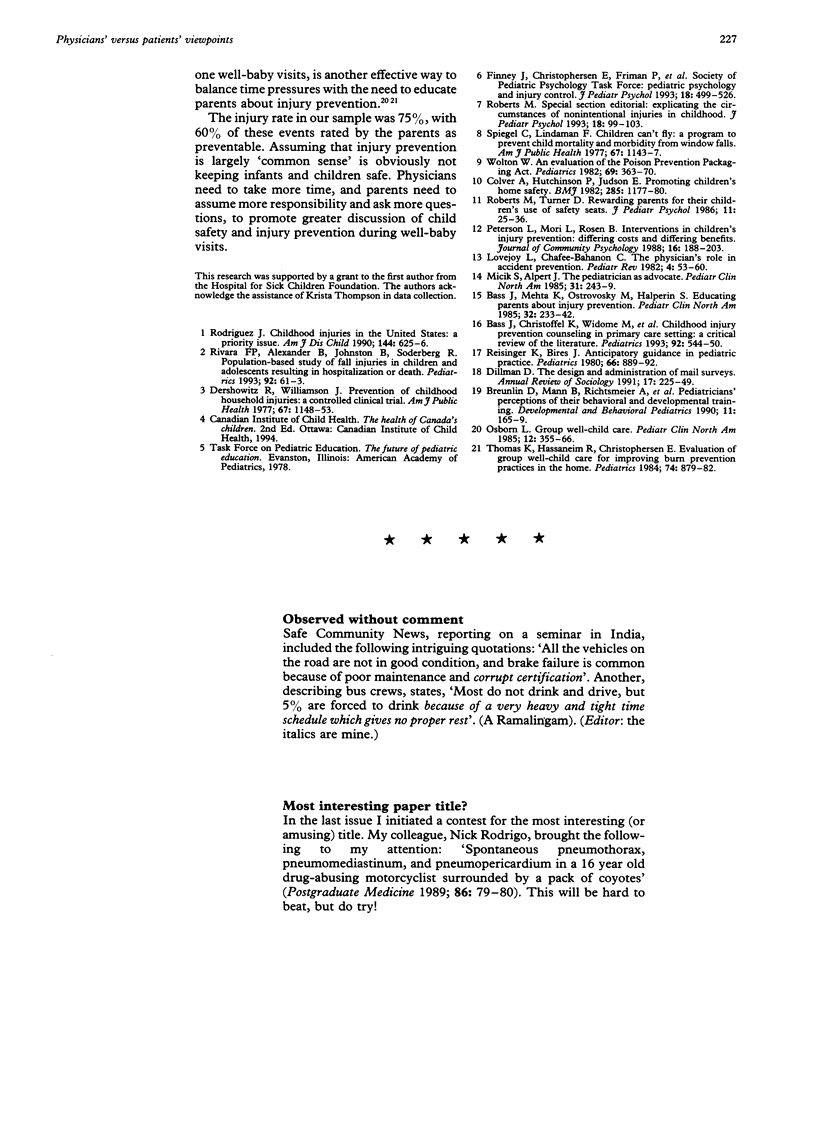Abstract
OBJECTIVE: Unintentional injuries are the number one cause of death for infants. Many of these injuries could be prevented if parents took additional safety precautions. In this study physicians' and parents' perspectives regarding the part that physicians play in educating first time parents about child safety issues were compared. METHODS: All pediatricians and family physicians in London, Ontario were surveyed by mail (68% return rate) regarding their practices, attitudes, and beliefs related to parent education about child safety issues. A sample of 114 first time mothers, including 38 each with 6, 12, and 18 month old infants, completed a telephone interview. All parents had physicians who had returned questionnaires. RESULTS: There was good correspondence between parents' and physicians' judgments about the safety issues most often covered, and what role physicians should adopt regarding parent education about child safety issues. In addition, they both agreed that parents seldom seek out safety information by asking questions. Relative to parent reports, however, physicians significantly overestimated the time they spent on safety issues and the degree of their direct involvement in communicating this information. The best predictor of time spent by physicians on safety issues was their rating of the importance of assuming the role of parent educator. The best predictor of parents asking questions about child safety was their rating of the adequacy of physicians' responses to previously asked questions. CONCLUSIONS: The results suggest that both physicians and parents contribute to undermine communication about child safety during well-baby visits.
Full text
PDF




Selected References
These references are in PubMed. This may not be the complete list of references from this article.
- Bass J. L., Christoffel K. K., Widome M., Boyle W., Scheidt P., Stanwick R., Roberts K. Childhood injury prevention counseling in primary care settings: a critical review of the literature. Pediatrics. 1993 Oct;92(4):544–550. [PubMed] [Google Scholar]
- Bass J. L., Mehta K. A., Ostrovsky M., Halperin S. F. Educating parents about injury prevention. Pediatr Clin North Am. 1985 Feb;32(1):233–242. doi: 10.1016/s0031-3955(16)34770-8. [DOI] [PubMed] [Google Scholar]
- Breunlin D. C., Mann B. J., Richtsmeier A., Lillian Z., Richman J. S., Bernotas T. Pediatricians' perceptions of their behavioral and developmental training. J Dev Behav Pediatr. 1990 Aug;11(4):165–169. [PubMed] [Google Scholar]
- Colver A. F., Hutchinson P. J., Judson E. C. Promoting children's home safety. Br Med J (Clin Res Ed) 1982 Oct 23;285(6349):1177–1180. doi: 10.1136/bmj.285.6349.1177. [DOI] [PMC free article] [PubMed] [Google Scholar]
- Dershewitz R. A., Williamson J. W. Prevention of childhood household injuries: a controlled clinical trial. Am J Public Health. 1977 Dec;67(12):1148–1153. doi: 10.2105/ajph.67.12.1148. [DOI] [PMC free article] [PubMed] [Google Scholar]
- Finney J. W., Christophersen E. R., Friman P. C., Kalnins I. V., Maddux J. E., Peterson L., Roberts M. C., Wolraich M. Society of Pediatric Psychology Task Force Report: pediatric psychology and injury control. J Pediatr Psychol. 1993 Aug;18(4):499–526. doi: 10.1093/jpepsy/18.4.499. [DOI] [PubMed] [Google Scholar]
- Micik S. H., Alpert J. J. The pediatrician as advocate. Pediatr Clin North Am. 1985 Feb;32(1):243–249. doi: 10.1016/s0031-3955(16)34771-x. [DOI] [PubMed] [Google Scholar]
- Reisinger K. S., Bires J. A. Anticipatory guidance in pediatric practice. Pediatrics. 1980 Dec;66(6):889–892. [PubMed] [Google Scholar]
- Rivara F. P., Alexander B., Johnston B., Soderberg R. Population-based study of fall injuries in children and adolescents resulting in hospitalization or death. Pediatrics. 1993 Jul;92(1):61–63. [PubMed] [Google Scholar]
- Roberts M. C., Turner D. S. Rewarding parents for their children's use of safety seats. J Pediatr Psychol. 1986 Mar;11(1):25–36. doi: 10.1093/jpepsy/11.1.25. [DOI] [PubMed] [Google Scholar]
- Rodriguez J. G. Childhood injuries in the United States. A priority issue. Am J Dis Child. 1990 Jun;144(6):625–626. doi: 10.1001/archpedi.1990.02150300019014. [DOI] [PubMed] [Google Scholar]
- Spiegel C. N., Lindaman F. C. Children can't fly: a program to prevent childhood morbidity and mortality from window falls. Am J Public Health. 1977 Dec;67(12):1143–1147. doi: 10.2105/ajph.67.12.1143. [DOI] [PMC free article] [PubMed] [Google Scholar]
- Thomas K. A., Hassanein R. S., Christophersen E. R. Evaluation of group well-child care for improving burn prevention practices in the home. Pediatrics. 1984 Nov;74(5):879–882. [PubMed] [Google Scholar]
- Walton W. W. An evaluation of the Poison Prevention Packaging Act. Pediatrics. 1982 Mar;69(3):363–370. [PubMed] [Google Scholar]


